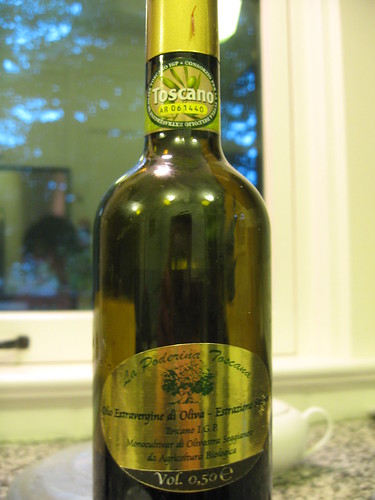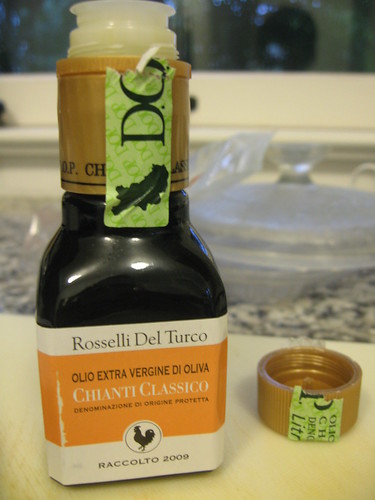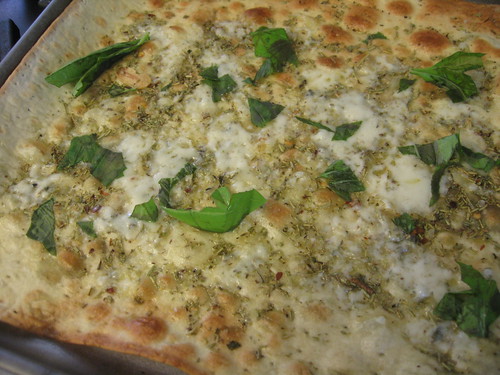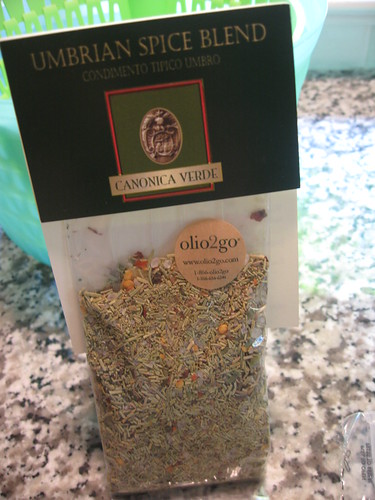
(photo: The Canonica Verde Umbrian Spice Blend including rosemary, sea salt, garlic, and red pepper flakes)
Click here for my other olive oil reviews!
As you’ve probably noticed, Olive Oil and Pasta are at the heart of Italian cuisine (both above and below the mezzogiorno, the geopolitical dividing line of Italy). Specifically, my love for both products started in Nonna Scordo’s New Jersey basement (we all lived in the same two family home for a few years before my parents purchased their own home). As a small boy I was incredibly skinny and, as the legend goes (Italian mothers are tremendous storytellers with penchants for stretching empirical truths), I would not eat much. One day, Nonna Scordo discovered I had a particular fondness for large rigatoni rigate with her blended olive / corn oil mixture (olive oil, athough still expensive today, was particular difficult to acquire in the mid 1970’s through the mid 1980’s, at least for folks in the lower to middle class ranks in the US), hence Nonna’s move to stretch her olive oil. Neverthless, rigatoni with oil and an abundance of mixed (again another “food stretch”) Pecorino Romano and Pamigiano Reggiano cheese became my favorite meal (allowing me to reach puberty with some fat on my bones).

(photo: the Zitoni Cararecci – notice the length of this mammoth pasta shape!)
As a dish, pasta with olive oil is still one of my favorite simple pleasures in life and I, indeed, wax philosophical about my beloved Nonna Scordo every time I take a bit of rigatoni. One such emotional moment came when I bit into a piece of Zitoni Casarecci from the producer Pastificio Vicidomini. While I had the Zitoni with a chicken ragu, when I tried the pasta during the cooking process it had the same texture, mouth feel, and flavor of the rigatoni Nonna Scordo made in her kitchen. More specifically, the Zitoni Casarecci had starchy and complex overtones, and while it didn’t have the crunch and whole wheat flavor of
Rustichella pasta, it certainly tasted and behaved (yes pasta must behave when cooked and tossed with the condiment) like a top flight Italian pasta. Zitoni, as I mentioned in my last
Scordo Pasta Challenge post, was a “special occasion” pasta in Italy. As my mother describes, she would often be sent to the local shop near her Calabrian home to purchase a few kilos for Easter or Christmas lunch. Because of the length of
Zitoni Casarecci it is cut into pieces by the cook and the size can vary according to whichever pasta dish is being prepared.

(photo: the organic extra virgin olive oil from La Poderina from Grosseto)
On the olive oil side, I was fortunate to try two new olive oils from Italy this past week, including an organic oil from Grosseto La Poderina Toscana IGP, Seggianese monocultivar (made via a unique process called
Sinolea) and a Tuscan variant, Rosselli del Turco DOP Chianti Classico.
Click here to read about the labels IGP, DOP, etc as they are applied to foods and wines in Italy.
The
Grosseto La Poderina is a solid extra virgin oil and can, indeed, be used as an everyday olive oil. The relatively low acidity I found in the oil makes it a nice oil to try if you’re new to consuming extra virgin olive oil. I found the organic oil to be great with tomatoes, a salad of beet greens, and in salad dressings. Color was outstanding with nice green/yellow contrast.

(photo: the super pungent Rosselli del Turco extra virgin olive oil)
The Rosselli del Turco was another beast entirely. In fact, the smallish bottle that the oil is packaged in leads one to think automatically that Rosselli is a serious extra virgin. So serious, in fact, that the
shop carrying the product claims that it has one of the highest levels of polyphenols of any olive oil they’ve come across (think of polyphenols as tannins, like found in wine; the medical theory is that there’s a correlation between the consumption of polyphenols and good health)! Science aside, the oil was indeed pungent and overly peppery and bitter (I’ve had first cold pressed extra virgin olive oil straight from the press and the intensity didn’t compare to the “attack” at the end of the palate the
Rosselli produced; I actually coughed after tasting it). In fact, on it’s own (say with bread), I’d say it’s a bit much for the American palette, but when drizzled on a piece of
skirt stake with lots of black pepper it’s quite good and can finish a dish that has complex flavors (maybe a piece of Bluefish or Swordfish for example). The color of the oil was a neutral yellow.

(photo: lavish pizza made with the Umbrian Spice Blend)

Finally, I sampled a spice packet containing an Umbrian blend (Canonica Verde Umbrian Spice Blend) of chili pepper, garlic, salt, parsley, and rosemary. I was a bit hesitant to try a “blend of spices” because I’m accustomed to receiving herbs dryed in Italy from my family in individual containers (including oregano, red pepper flakes, rosemary, etc.) – the blending usually happens at home and for a given meal or dish. Nevertheless, I sampled the packet on two dishes, first a
lavash pizza with extra virgin olive oil, fresh basil, and provola and second a
roast chicken. The spices proved to be a bit salty when used on the pizza, with only the sea salt and rosemary flavor components coming through. However, when I rubbed the
blend in a whole chicken and roasted the bird with a bit of olive oil, the spices blended together nicely and both the quality and flavor of the mix came though (including the chili peppers and garlic).
All the products above can be found in the wonderful online shop
Olio2go.com.
Related Posts from Scordo.com
 Author: Vincent Scordo
Author: Vincent Scordo
Lead Italophile (and/or lover of all things Italian).








Chestnut Honey is sublime with the pairing of gorgonzola and walnuts. It makes a wonderful glaze for your Thanksgiving turkey. Chestnut Honey can make a spectacular appetizer with a small plate, dollop of good ricotta, on a bed of arugula, and a swirl of chestnut honey. It is excellent with teas and bread, and is a fabulous addition to cheese. Honey adds something special to marinades and vinaigrettes. A taste sensation with yogurt! For breakfast or an afternoon snack, drizzle chestnut honey over a dollop of yogurt and top with walnuts.
One Plate Summer Lunch: Tomatoes, Whole Milk Mozzarella, and Oil Cured Sardines
Lazy, weekend, lunches are one of the small pleasure in life and I define a lazy lunch as a simple plate of food (with little to no manipulation), fresh, crunchy, bread, and a bottle of exquisite wine (psychologically, get…
The Italian Pantry – 12 Ingredients To Keep In Your Kitchen at All Times
(photo: a typical trip the market for some fresh ingredients for our kitchen, including bread, fruit, whole chicken, yogurt, etc.) I’ve always equated good cooking with being prepared, just like a fine carpenter has the necessary tools to build…